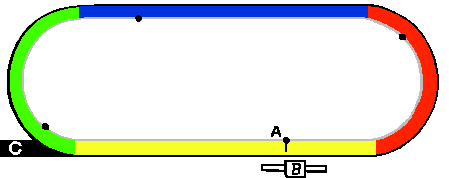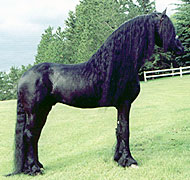|
Backstretch
Backstretch refers to either: (1) the portion of an oval racetrack on the far side of the grandstand, parallel to the homestretch, or, (2) particularly in North America, the area near the racetrack where horses are stabled and the daily work of maintaining the horses occurs. In many racetracks, the stabling area is located next to the far side of the track, and may also be called "the other side of the track" or the "backside". Portion of the racetrack The standard definition of backstretch refers to the configuration of an oval racetrack, where the backstretch is parallel to the homestretch. It is shown in blue on the adjacent diagram. On an oval track, sprint races (typically 7 furlongs or less) begin on the backstretch and go around one turn to the finish line. Longer races start in the homestretch, take one turn into the backstretch, then another turn into the homestretch, so may be called "two turn" races. Depending on the track dimensions, very long races may consist of three ... [...More Info...] [...Related Items...] OR: [Wikipedia] [Google] [Baidu] |
Racetrack
A race track (racetrack, racing track or racing circuit) is a facility built for racing of vehicles, athletes, or animals (e.g. horse racing or greyhound racing). A race track also may feature grandstands or concourses. Race tracks are also used in the study of animal locomotion. A ''racetrack'' is a permanent facility or building. ''Racecourse'' is an alternate term for a horse racing track, found in countries such as the United Kingdom, India, Australia, Hong Kong, and the United Arab Emirates. Race tracks built for bicycles are known as ''velodromes''. ''Circuit'' is a common alternate term for race track, given the circuit configuration of most race tracks, allowing races to occur over several laps. Some race tracks may also be known as ''speedways'', or ''raceways''. A ''race course'', as opposed to a ''racecourse'', is a nonpermanent track for sports, particularly road running, water sports, road racing, or rallying. Many sports usually held on race tracks also can occur ... [...More Info...] [...Related Items...] OR: [Wikipedia] [Google] [Baidu] |
Stable
A stable is a building in which livestock, especially horses, are kept. It most commonly means a building that is divided into separate stalls for individual animals and livestock. There are many different types of stables in use today; the American-style barn, for instance, is a large barn with a door at each end and individual stalls inside or free-standing stables with top and bottom-opening doors. The term "stable" is also used to describe a group of animals kept by one owner, regardless of housing or location. The exterior design of a stable can vary widely, based on climate, building materials, historical period and cultural styles of architecture. A wide range of building materials can be used, including masonry (bricks or stone), wood and steel. Stables also range widely in size, from a small building housing one or two animals to facilities at agricultural shows or race tracks that can house hundreds of animals. History The stable is typically historically t ... [...More Info...] [...Related Items...] OR: [Wikipedia] [Google] [Baidu] |
Generic Racetrack Diagram
Generic or generics may refer to: In business * Generic term, a common name used for a range or class of similar things not protected by trademark * Generic brand, a brand for a product that does not have an associated brand or trademark, other than the trading name of the business providing the product * Generic trademark, a trademark that sometimes or usually replaces a common term in colloquial usage * Generic drug, a drug identified by its chemical name rather than its brand name In computer programming * Generic function, a computer programming entity made up of all methods having the same name * Generic programming, a computer programming paradigm based on method/functions or classes defined irrespective of the concrete data types used upon instantiation ** Generics in Java In linguistics *A pronoun or other word used with a less specific meaning, such as: ** generic ''you'' ** generic ''he'' or generic ''she'' ** generic ''they'' * Generic mood, a grammatical mood u ... [...More Info...] [...Related Items...] OR: [Wikipedia] [Google] [Baidu] |
Chaplain
A chaplain is, traditionally, a cleric (such as a minister, priest, pastor, rabbi, purohit, or imam), or a lay representative of a religious tradition, attached to a secular institution (such as a hospital, prison, military unit, intelligence agency, embassy, school, labor union, business, police department, fire department, university, sports club), or a private chapel. Though originally the word ''chaplain'' referred to representatives of the Christian faith, it is now also applied to people of other religions or philosophical traditions, as in the case of chaplains serving with military forces and an increasing number of chaplaincies at U.S. universities. In recent times, many lay people have received professional training in chaplaincy and are now appointed as chaplains in schools, hospitals, companies, universities, prisons and elsewhere to work alongside, or instead of, official members of the clergy. The concepts of a ''multi-faith team'', ''secular'', ''generic ... [...More Info...] [...Related Items...] OR: [Wikipedia] [Google] [Baidu] |
Horse Trainer
A horse trainer is a person who tends to horses and teaches them different disciplines. Some of the responsibilities trainers have are caring for the animals' physical needs, as well as teaching them submissive behaviors and/or coaching them for events, which may include contests and other riding purposes. The level of education and the yearly salary they can earn for this profession may differ depending on where the person is employed. History Horse domestication by the Botai culture in Kazakhstan dates to about 3500 BC. Written records of horse training as a pursuit has been documented as early as 1350 BC, by Kikkuli, the Hurrian "master horse trainer" of the Hittite Empire. Another source of early recorded history of horse training as a discipline comes from the Greek writer Xenophon, in his treatise On Horsemanship. Writing circa 350 BC, Xenophon addressed starting young horses, selecting older animals, and proper grooming and bridling. He discussed different approache ... [...More Info...] [...Related Items...] OR: [Wikipedia] [Google] [Baidu] |
Jockey
A jockey is someone who rides horses in horse racing or steeplechase (horse racing), steeplechase racing, primarily as a profession. The word also applies to camel riders in camel racing. The word "jockey" originated from England and was used to describe the individual who rode horses in racing. They must be light, typically around a weight of 100-120 lb., and physically fit. They are typically self-employed and are paid a small fee from the horse trainer and a percentage of the horse's winnings. Jockeys are mainly male, though there are some well-known female jockeys too. The job has a very high risk of debilitating or life-threatening injuries. Etymology The word is by origin a diminutive of ''jock'', the Northern England, Northern English or Scottish people, Scots colloquial equivalent of the first name ''John (name), John'', which is also used generically for "boy" or "fellow" (compare ''Jack (name), Jack'', ''Richard, Dick''), at least since 1529. A familiar instance of ... [...More Info...] [...Related Items...] OR: [Wikipedia] [Google] [Baidu] |
Horse Grooming
Horse grooming is hygienic care given to a horse, or a process by which the horse's physical appearance is enhanced for horse shows or other types of competition. Reasons for grooming Grooming is an important part of horse care. Grooming a horse daily allows the handler to check on the horse's general health and well-being. At a minimum, horses are generally groomed before being worked, and are usually groomed and cleaned up after a workout as well. Horse showmanship is a horse show class that considers quality of grooming for as much as 40% of the total score. The main reasons for daily grooming include: * Improved health of the skin and coat * Decreases the chance of various health problems such as thrush, scratches, and other skin problems * Cleans the horse, so chafing does not occur under areas of tack * Gives the groom a chance to check the horse's health, such as looking for cuts, heat, swelling, lameness, a change in temperament (such as depression) which could indic ... [...More Info...] [...Related Items...] OR: [Wikipedia] [Google] [Baidu] |
Farrier
A farrier is a specialist in equine hoof care, including the trimming and balancing of horses' hooves and the placing of shoes on their hooves, if necessary. A farrier combines some blacksmith's skills (fabricating, adapting, and adjusting metal shoes) with some veterinarian's skills (knowledge of the anatomy and physiology of the lower limb) to care for horses' feet. History While the practice of putting protective hoof coverings on horses dates back to the first century, evidence suggests that the practice of nailing iron shoes into a horse’s hoof is a much later invention. One of the first archaeological discoveries of an iron horseshoe was found in the tomb of Merovingian king Childeric I, who reigned from 458-481/82. The discovery was made by Adrien Quinquin in 1653, and the findings were written about by Jean-Jacques Chifflet in 1655. Chifflet wrote that the iron horseshoe was so rusted that it fell apart as he attempted to clean it. He did, however, make an ... [...More Info...] [...Related Items...] OR: [Wikipedia] [Google] [Baidu] |
Veterinarian
A veterinarian (vet), also known as a veterinary surgeon or veterinary physician, is a medical professional who practices veterinary medicine. They manage a wide range of health conditions and injuries in non-human animals. Along with this, vets also play a role in animal reproduction, animal health management, conservation, husbandry and breeding and preventive medicine like animal nutrition, vaccination and parasitic control as well as biosecurity and zoonotic disease surveillance and prevention. Description In many countries, the local nomenclature for a veterinarian is a regulated and protected term, meaning that members of the public without the prerequisite qualifications and/or licensure are not able to use the title. This title is selective in order to produce the most knowledgeable veterinarians that pass these qualifications. In many cases, the activities that may be undertaken by a veterinarian (such as treatment of illness or surgery in animals) are restricted ... [...More Info...] [...Related Items...] OR: [Wikipedia] [Google] [Baidu] |







